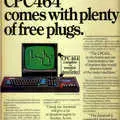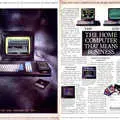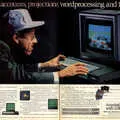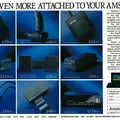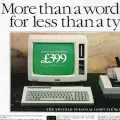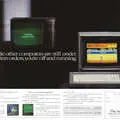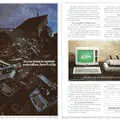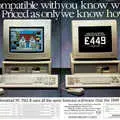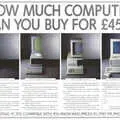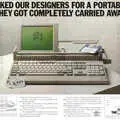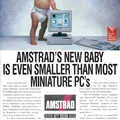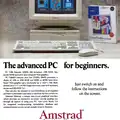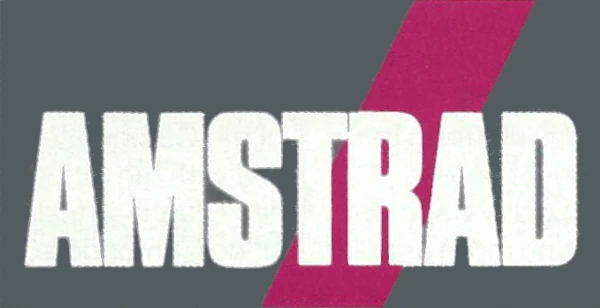
Amstrad Advert - March 1987
From Practical Computing
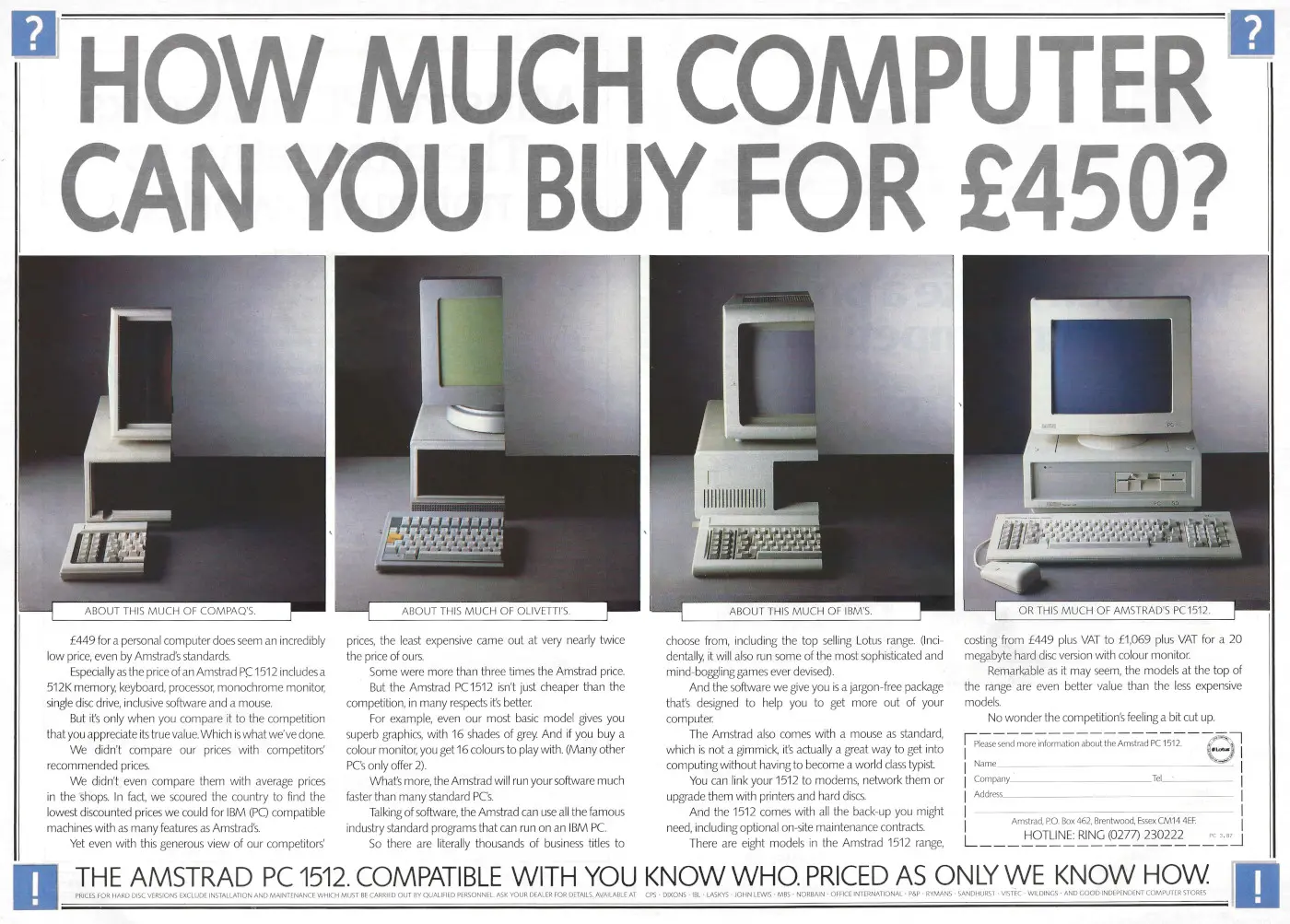
How much computer can you buy for £450?
It's another advert for Amstrad's PC 1512, this time featuring a nice bit of analogue Photoshopping showing competitors' micros chopped up to represent how much you could get for the cost of an Amstrad.
Amstrad started 1987 with its shares somewhere "in the doldrums" whilst it fended off continuing rumours that its PC was prone to overheating.
Even so, sales of the CPC range were still solid, the PCW word processor had been spectacularly successful and the release of the Spectrum Plus 2 the year before meant it had both the games market and the small business market effectively sewn up.
Nevertheless, Popular Computing Weekly was wondering where Amstrad's model of briefing its technical department to target an established market with a machine that cheaply and reliably met the needs of that market could go next, as it only had the cut-throat PC market left and it would need to move higher up the specification scale to get anywhere.
Alternatively, the company could aim at the games market, where Alan Sugar had previously expressed an interest when he bought Sinclair but where the company swiftly dropped Sinclair's Loki "super Spectrum" project upon acquisition.
Amstrad's problem with a console was that its record on software development was not especially good, and consoles needed lots of good software to survive.
Most of the successful software products for its CPC had come from conversions, and the PCW had relied on a large catalog of existing CP/M software, whilst much of Amstrad's own in-house efforts had "failed to set the world on fire".
Also, it was looking increasingly unlikely that producing a games console based on Spectrum compatibility would be helpful or cheap, leading as it would to a fiddly two-in-one approach - like Commodore's C128 - in order to balance backwards compatibility with the enhanced graphics and sound that a more modern audience would demand.
As Popular Computing Weekly pointed out, the "new" Spectrum Plus 2 was "simply a re-cased Spectrum 128, which is a Spectrum Plus with extra memory bolted on, which is a re-cased Spectrum 48K, which is an enhanced ZX81, which is a modified ZX80" from seven years earlier - a geological epoch in the micro industry - before putting the boot in by suggesting that "The standard will now need serious revision if it's to fight the Atari ST".
Amstrad's problem could be seen to be that in the past, it had been a market leader in terms of profits alone, and this profit was based on the practice of simply doing what the market leader was doing, but doing it better and cheaper.
Now that Amstrad had become the market leader in its own right, it was now having to "innovate rather than emulate", and this was something the marketing-heavy company was not so good at.
John Lettice concluded "1987 could either be the year Amstrad starts investing heavily in R&D, or it could be the year the company starts making fridges"[1].
Amstrad at least got a modest boost from the Open University in March, when it was announced that it had been chosen to supply 80% of a 4,500 computer order, funded by a £2.25 million grant from the Department of Trade and Industry (DTI).
Amstrad was to supply 2,250 PC 1512s along with DMP 3000 printers, with clone company Akhter making up the rest - the machines were to be used for a pool of PCs that could be rented by students and while the OU had 4,500 students on IT courses for 1988, it was expecting around 13,000 by 1990[2].
Amstrad's PC1512 seemed to have had an adverse affect on sales of the PCW 8512 model - the improved version of the game-changing word processor that Amstrad had first launched in 1985 - with reports from dealers suggesting that the 8512 wouldn't be available for much longer.
Derek Jones of Wrexham Computer Center was at least one dealer to take exception with the suggestion that sales of the 8512 were poor, saying that 8512 had been outselling the older 8256 model by a factor of three.
However Amstrad seemed to be streamlining its product range and that perhaps left room for only one word processor and one PC, with the cheaper 8256 remaining the choice for that particular market[3].
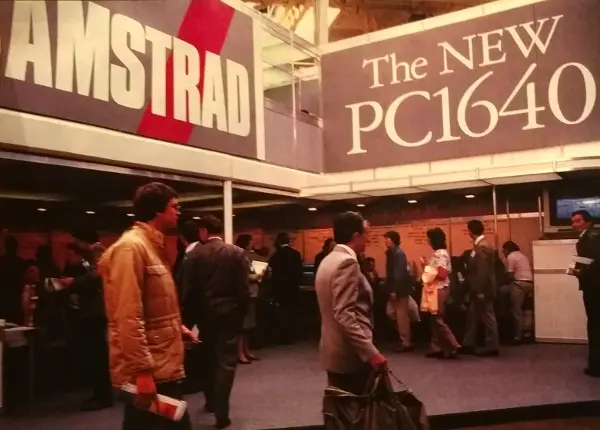
Amstrad launches the PC1640 at the 1987 Personal Computer World Show in Olympia, © PCW September 1988By the end of 1987, Amstrad's increasing reliance on the ruthlessly-competitive and uncertain IBM PC clone market was haunting its stock price, which had seen the City's confidence in Amstrad at "a low ebb".
The company's stock price was also sliding, whilst analysts Philips and Drew had been issuing "sell" recommendations on Amstrad stock for the whole of the summer of 1987.
By the end of August, the PC1512 had become the next target of price-cut rumours, following news that Dixons, thanks to its direct supply links with the machine's South Korean manufacturers, had cut £200 off its price - making the 20Mb, colour monitor and 1-year service contract machine only £1,175 (£4,300).
Other dealers were up in arms, but Amstrad was non-commital, adding helpfully that "If and when any price changes are to be made to any of our products, we will make a public announcement".
Nevertheless, Popular Computing Weekly was suggesting that stagnant sales of the 1512 coupled with the launch of the PC1640 meant a price drop would be "more than likely"[4].
Amstrad appeared so keen to promote its business side that at the July Amstrad Computer show at Alexandra Pavilion in North London there was "hardly a game in sight", whilst New Star's stand seemed to emphasis the general shift in attention away from the older consumer-focussed PCW machines[5].
The PC1640 was launched at Comdex, held in Atlanta, Georgia, in early June and was initially aimed at more specialist markets, so as not to cannibalise sales of the existing PC1512, which was being left to the mass market[6].
The '1640 was also the machine which Popular Computing Weekly considered Amstrad's "last, major stab" at the US market, following previous failures, although it was already disappointing some observers as it failed to be the 80286-based machine that some were expecting.
Indeed, it looked like there was going to be no 80286 PC from Amstrad in the forseeable future.
Meanwhile, Amstrad and its affiliates seemed confident, as president of US distributor Vidco suggested "The breadth of product now offered by the combination of the PC1512 and the PC1640 models allows us to approach all sections of the marketplace".
There was also a move to position the PC1640 with more specialist retailers, rather than the High Street/Chainstore outlets of the previous machines.
This clearly implied a price rise, or as Amstrad's marketing director Malcolm Miller stated "We have not yet set our pricing structure for the PC1640 in Europe, but initial indications are that this model will be significantly more expensive than the PC1512 range"[7].
However, news of the early shipping of the 1640, which had been brought forward from the previous expected date of new year 1988 and which meant that the machine could now be previewed at the July '87 PC User Show, caused some trouble for Amstrad.
The news appeared to spark some speculation in financial circles that Amstrad's future was "not as rosy as it appeared", with Phillips and Drew as well as Chase Manhattan Securities actively downgrading their '88 forecasts for the company.
The announcement of the early shipping also seemed to confirm market research rumours that sales of the 1512 were only half of the 70,000 target set the previous September, and also put pressure on the earlier machine, resulting in a fall of 20% on Amstrad's share price.
Sales and Marketing head Malcolm Miller vigorously denied rumours that the 1512 was for the chop, saying "There has been [a] persistent rumour that we will be dropping the PC1512, but I can confirm that there is no question of [it] being discontinued".
He went on to concede that "Although the PC1512 has sold well into the business sector, we recognise that the corporate customer, which we defines as 'bulk orders through central purchase' has not bought the PC1512 in large quantities".
The company was clearly hoping that its new 1640 EGA (Enhanced Graphics Adapter) model would "satisfy the demands of the business sector"[8].
Whilst it might have been for the chop in the UK, over in Poland, Amstrad's PC 1512 was only just becoming available, alongside imported IBM PCs, Star Micronics printers and Maxell floppy disks, thanks in part to Gorbachev's Perestroika and Glasnost policies.
The machines weren't cheap though, which revealed if nothing else that they wouldn't be available to the proles any time soon. An entry-level Amstrad could be had for 2,095,000 zloty - the equivalent of $8,729, or about £21,300 in 2025, or two Polish FSO 1500 saloon cars.
A colour Amstrad with a 20MB hard disk clocked in at 5.8 million zloty - that's £59,200 now, apparently enough to buy an entire fleet of luxury FSO Polonez cars[9].
Meanwhile, during a press conference at the PC user show in early July, Alan Sugar was hitting back at the analysts whose downgraded forecasts had wiped "thousands of pounds" off Amstrad's share price the month before, saying disparagingly that "The City is followed by analysts, those who get their information from journalists and going along to Dixons".
He also lobbed some brickbats at new-ish company Dell Computer Corporation, whose new-fangled mail-order system he seemed to take issue with, patronisingly suggesting that "The British consumer's a little bit smarter than one in North America".
Despite the fact that Dell had posted a turnover of $70 million the year before and was showing strong growth in the PC business, Sugar reckoned that he "didn't know whether Dell would make it on the European front"[10].
As of 2016, Dell, with a market capitalisation of around $23 billion, was the third-placed PC manufacturer behind Lenovo, which bought IBM's computer unit, and HP[11].
The Amstrad effect
The fact that Amstrad was even in the same ballpark as Dell and HP was a testament to the "Amstrad effect", as Popular Computing Weekly called it.
Seemingly content with good sales of its PCW machines, the company nevertheless moved fast to pull a PC out of the bag by the summer of 1986 and by the end of its first year as a PC manufacturer it had achieved significant success with this first clone, with machines "walking off the shelves for the first nine or ten months after launch".
Only a year later it was shipping a new PC - upgraded and with EGA graphics - all of which put paid to early scepticism that it was only dabbling in computers and would soon move off to do "fridges, CD players, portable telephones, whatever", as the business market was forced to take the company seriously.
However although computers were now making up around half of Amstrad's revenues, the company was in a difficult place as it was not in a position to actually develop new technology, but instead had to consantly seek out new buyers for its tried-and-tested (i.e. older) technology all the time.
Not least of the challenges up against it was the famous tendency of corporates to buy IBM, because no-one ever got fired for buying IBM.
There was also Amstrad's image as a manufacturer of £99 combined-TV-and-video-recorders to deal with, plus dogged rumours surrounding the overheating-related safety of the PC1512, claims about exactly how many machines Amstrad was actually selling into the business market and the aforementioned lack of City credibility.
On the home side, where such issues were irrelevant and where its £5 million buy-out of Sinclair was reaping dividends, the company still had a problem that it had nothing to replace the ageing Spectrum series and could be left without any contender for the home market by the end of 1988, as Atari STs and even the Amiga headed towards the Spectrum's price point.
Amstrad was in the situation of having to wait and see what other manufacturers did, but in the meantime was pitching its future largely at the difficult corporate market[12].
Being ignored by the City didn't seem to be affecting Amstrad too much, at least according to a survey undertaken towards the end of 1988.
The "PC Purchasers Readership Survey", undertaken by market researchers PCMR and available for the bargain price of £695 (£2,440 in 2025), had analysed the PC buying habits of companies in the Times 1000, or more specifically those companies whose PC buyers ran departments of at least 1,000 employees and already had at least 50 PCs installed.
It showed that, yes in this sort of market, it seemed that IBM really did rule the roost, coming in with over 80% of companies having IBM PCs installed.
Compaq was bringing up the rear with just over 50% but Amstrad, perhaps surprisingly, was in third place with 43% of the market.
However, the survey also revealed that just over 40% of the Amstrad buyers were only planning on buying 25 machines or less, whilst the buyers planning on 500 or more machines were only buying Compaq, IBM or Toshiba.
It did seem like a proper "class divide", with the purchasers of low-cost clones much less likely to buy in bulk, whilst being much more cost-conscious in general than those who went with IBM[13].
Back in 1987, long-rumoured price cuts officially arrived in September, when the PC1512, Spectrum Plus 3 and PCW were all reduced, with effect from the first day of the Personal Computer World show, which started on September 23rd.
The price of the Plus 3, which according to Popular Computing Weekly was widely considered to be uncompetitive, was slashed to £199, whilst the price of the PC1512 was lopped by £50, which essentially restored the machines to their launch price from the previous year.
Meanwhile, the prices of the existing PCW machines were dropped in order to make way for the forthcoming PCW 9512, which had already been launched in the US but was not being launched in the UK until the Personal Computer World show[14].
Despite all the gloom about the state of the PC1512 market earlier in the summer, it was revealed in September that Amstrad had actually shifted 450,000 of the things between its launch the previous September and June 1987.
That was on top of an impressive 750,000 PCW8256/8512's[15].
With sales figures that most other companies could only dream of notwithstanding, Alan Sugar was still on the lookout for new customers, as he suggested that the PC1512 was poised to take over the home computer market where the PCWs were doing well.
"Price tips the scales" seemed to be his motto, and in a nod to Jack Tramiel's quote from Henry Ford, who had suggested that "for every dime you remove from the cost, a whole new stratum of buyers is revealed"[16], Sugar was expecting that the reduction in the price of the PCW to £299 would spark off another chain of consumers. Or as he put it:
"First there was the bold, going out an buying it and sitting down and punching away, and then there was the less bold observing. And then the less bold observed that the first one was actually using it. We're now looking for the stingy"[17].
Sugar also offered an insight into the mystery of the Spectrum as he compared it to the "suntan lotion market", or in other words how Amstrad was still expecting to shift 200,000 of the ageing 8-bit machine during the Christmas of 1987.
Sugar positioned the company's philosophy on whether or not to drop a machine as very much "we'll make it as long as it sells", before continuing that
"Any market where we see a possibility of selling at least 3-4,000 pieces a week of anything, we're interested in it. Now if that market's declining or not is irrelevant, [but] if it declines to something like 55 pieces per annum, well, we'll respectfully butt out".
At around the same time, the writing was on the wall for the company's older CPC range of home micros.
With the future of the range already in doubt, Amstrad had fuelled speculation by dropping the price of its Spectrum Plus 2 and 3 models - the latter by £50 - as well as bundling the machines with a joystick and 17 games, thus eating into its own CPC market.
The news that WH Smith was dropping the CPC didn't help either - the High Street newsagent had already cancelled advertising of the machines in a number of magazines, and the company's computer buyer, Ian Laurie, admittied that Smiths was "no longer handling it - it is not a line we will continue selling".
Amstrad meanwhile denied that the Spectrum price cuts had been made in response to industry pressure, but that it was simply a "commercial move" and that there was no information forthcoming about the future of the CPC machines[18].
Screens of death
Like its predecessors, the PC1640 came with a choice of mono or colour monitor, at a time when there was rising panic about the dangers of VDU use.
There were books such as "The VDU Hazards Handbook", published in June, which detailed facts such as "VDU operators are twice as likely as other clerical workers to suffer from Angina".
It also offered "A VDU operator sitting 18 inches from the screen experiences a postitive electrical charge of 150 volts per square inch", as well as the particularly-scaremongering "low-frequency radiation like that emitted from VDUs has been shown to cause deformities in the foetuses of rabbits, rats and chickens"[19] - claims clearly designed to terrify any foetuses that happened to be operating a computer.
This built on fears nurtured by the publishing of a report commissioned by the National Association of Local Government Officers (NALGO) union in May, which examined the effects of prolonged VDU use on 3,000 of its staff employed at Newham Borough Council in London.
The survey found that more than 75% of respondants complained of blurred vision and painful eyes, as well as depression plus stress brought on by "computer breakdowns and printer noise".
Whilst Norway, Sweden and West Germany were protected by legislation, users in the UK weren't, which prompted campaign worker Irene Hamilton to state that "We can't understand the reluctance to have VDUs built in to current standards.
It's vitally important they are, and all equipment should come with an anti-glare screen and a detachable keyboard" - a sign perhaps that the era of the all-in-one like the 1977 PET was truly over.
Hamilton also suggested that all VDUs should be shielded against electro-magnetic radiation at the point of manufacturer, neatly skipping over the fact that shielding a monitor from giving out that pesky electro-magnetic radiation that was light would render it less than effective[20].
TV from spaaaace
Amstrad's declining stock price was reversed in September after stories started circulating that the company was looking to go into partnership with a satellite broadcasting consortium in 1988. Phillips and Drew's Ruth Keattch said
"We see Amstrad running into sales problems in '87/'88 because computer sales are beginning to come under pressure. We would like to see the company diversifying into something now, and we were hoping that Amstrad would have announced a move into white goods, but it does appear to have missed opportunities".
Meanwhile Amstrad itself played down the stories and issued a statement saying that
"Amstrad is watching the market for satellite television reception, and if this market ever becomes popular resulting in high demand for receiving equipment it is not unreasonable to assume Amstrad will have an extreme interest in becoming a major vendor"[21].
In October, Alan Sugar had the chance to round on critics, both from the financial sector and the computer industry, when Amstrad reported pre-tax profits for 1987 of nearly £136 million - an increase of more than 80% over the previous year.
Commenting on worries about its reliance on the PC market, Sugar stated
"We are not a company that lives or dies by the success of any one product. The [PC1512] attracted tremendous interest and, in my opinion, has revolutionised the so-called computer industry in the UK. The Amstrad effect of low price, high volume production and marketing has taken the wind out of an industry cocooned in a sedate and un-competitive environment, encapsulated in a hyped-up aura of mystical high-technological sophistication".
Meanwhile, rumours were surfacing that Amstrad was launching a new computer in the US some time in November, despite having denied that the company planned to enter the AT or 80386 market at all in 1987.
The word was that the new machine would be an MS-DOS-compatible portable with a back-lit supertwist LCD display and 3½" floppy drives, and would ship for around £400 - a price thought to be somewhat challenging unless the company re-badged an existing machine, a move which Sugar wasn't thought to be too keen on[22].
Date created: 05 March 2024
Last updated: 11 December 2024
Hint: use left and right cursor keys to navigate between adverts.
Sources
Text and otherwise-uncredited photos © nosher.net 2025. Dollar/GBP conversions, where used, assume $1.50 to £1. "Now" prices are calculated dynamically using average RPI per year.
